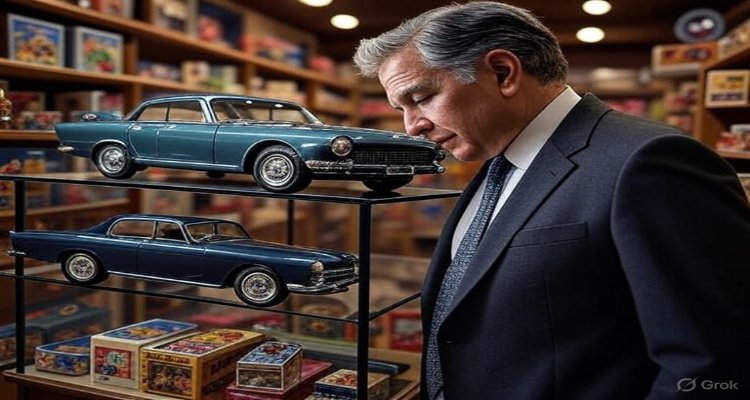Why Rich People Are Buying Back Their Childhoods
Wealthy collectors are spending millions to reclaim nostalgic pieces from their youth—from vintage toys to classic cars—revealing how luxury has become deeply emotional.
Introduction: When Nostalgia Becomes a Luxury
In 2025, nostalgia isn’t just sentimental—it’s an investment. From multimillion-dollar auctions of vintage Pokémon cards to billionaires restoring 1980s arcade machines, the world’s wealthy are buying back fragments of their youth. What began as harmless collecting has evolved into a global market of emotional luxury—where childhood memories now carry six-figure price tags.
The Rise of Emotional Wealth
Wealth used to be measured in tangible assets—real estate, art, yachts. But in recent years, emotional value has entered the equation. Psychologists describe this trend as “nostalgia capitalism”—the monetization of memory.
As millennial and Gen X millionaires reach peak earning years, they’re turning their disposable income toward the things that once brought them joy: rare comic books, retro video games, or even first-generation iPods. Auction houses like Sotheby’s and Heritage Auctions have capitalized on this boom, with sales of vintage collectibles reaching record highs.
In 2022, a sealed copy of Super Mario 64 sold for over $1.5 million, while a rare Star Wars action figure fetched nearly $500,000. The message is clear: memories are the new status symbols.
From Toys to Tech: The New Vintage Economy
The “buying back childhood” phenomenon stretches across categories—each representing a different slice of the past.
- Toys & Games: Elite collectors are snatching up vintage LEGO sets, Hot Wheels cars, and unopened Pokémon packs, often vaulting them like fine wine.
- Technology: The first iPhones, Sony Walkmans, and Macintosh computers have entered the luxury market, refurbished and reimagined as cultural artifacts.
- Cars & Music: Classic cars like the 1990 Ferrari F40 and vinyl record collections from the 1970s are being restored—not for resale, but for emotional satisfaction.
As one luxury consultant puts it, “We’ve reached a point where owning your childhood again is the ultimate form of control.”
The Psychology Behind the Purchase
Experts suggest the phenomenon is less about collecting—and more about coping.
Dr. Marissa Leung, a behavioral economist at Stanford, notes:
“Nostalgia provides stability in uncertain times. When the world feels unpredictable, the past feels safe—and the wealthy have the means to reconstruct that safety.”
Economic volatility, pandemic stress, and the rise of digital life have all driven a yearning for simplicity. For many, revisiting childhood through possessions offers a rare sense of authenticity in an age of algorithms and AI.
Moreover, owning tangible objects—rather than fleeting digital experiences—gives a sense of permanence. A mint-condition Nintendo or an original Barbie doll isn’t just a toy; it’s a time machine.
Luxury Meets Sentiment: The Business of Memory
Brands have noticed. Companies like Mattel, Hasbro, and Nintendo are relaunching “heritage editions” of their most iconic products—crafted with premium materials and aimed squarely at affluent adults.
Meanwhile, new businesses are emerging solely to cater to nostalgic wealth:
- Restoration studios that refurbish old arcade machines.
- Curated memory boutiques selling verified collectibles.
- Private nostalgia clubs, where members trade and showcase their childhood treasures like art investors.
According to MarketWatch, the global vintage collectibles market could exceed $60 billion by 2030, driven primarily by wealthy millennials seeking emotional returns on their investments.
Public Reaction: Relatable or Ridiculous?
Reactions to this trend are mixed. Online, some see it as indulgent—“millionaires buying toys while the world burns.” Others view it as relatable, if not aspirational.
Social media is filled with hashtags like #RetroLuxury, #CollectibleCulture, and #NostalgiaWealth, where users flaunt rare finds from their youth. The tone is part irony, part envy.
But for psychologists and economists, it signals a deeper cultural shift: wealth is no longer about newness or excess—it’s about meaning.
The Future of Memory as Currency
As nostalgia becomes monetized, experts warn of a possible bubble. Collectibles markets are notoriously volatile—what’s priceless today can plummet tomorrow. Yet, for many rich collectors, financial gain isn’t the point.
They’re not investing—they’re healing.
And in that sense, the trend reveals something profoundly human: even with infinite resources, the one thing people can’t buy is time. So they buy its echoes instead.
Conclusion: Reclaiming the Past in a Fast Future
In a world racing toward AI, automation, and virtual reality, the ultra-rich are reaching backward—to the tactile, the analog, the familiar. Whether it’s a restored Game Boy or a first-edition comic, these purchases reflect a yearning not just for childhood, but for connection.
As one collector told The New Yorker:
“Owning the things that made me happy reminds me of who I was—before everything became complicated.”
Perhaps that’s the ultimate luxury: not the price tag, but the peace of remembering who you used to be.
Disclaimer: This article is for informational and editorial purposes only. It does not constitute financial advice or endorsement of collectible investments.











